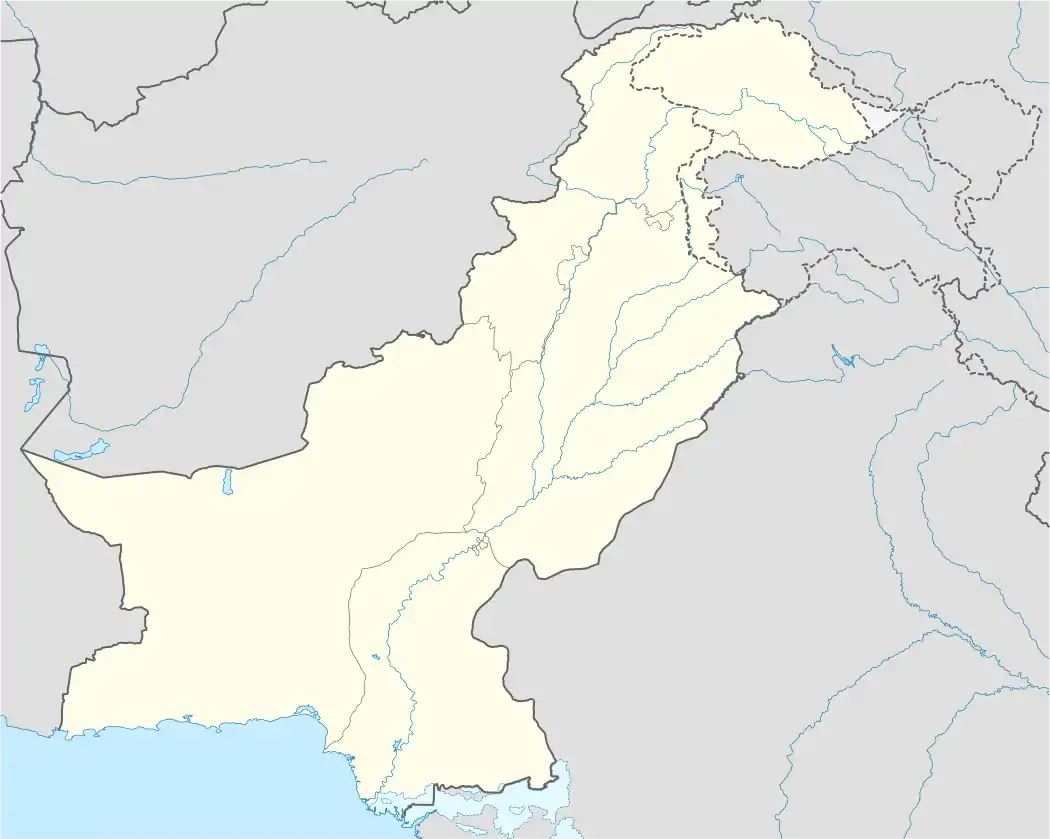Ahmedpur Sial
Ahmadpur Sial (Urdu: احمد پُورسیال), is a city in Jhang District in the Punjab province of Pakistan. The city is the headquarters of Ahmedpur Sial Tehsil which an administrative subdivision of the district. Its population in 1998 was 13,131.[1]
Ahmadpur Sial
احمد پُورسیال | |
|---|---|
City | |
 Ahmadpur Sial | |
| Coordinates: 30.41°N 71.46°E | |
| Country | |
| Province | Punjab |
| District | Jhang District |
| Tehsil | Ahmedpur Sial Tehsil |
| Elevation | 119 m (390 ft) |
| Population (1998) | |
| • Total | 13,131 |
| Time zone | UTC+5 (PST) |
History
The Ahmadpur and Garh Mahraja domains were added to the possessions of the Rajbana Sial tribe who had driven out the Baloch to the Thal and defeated the Nawab of Multan by the late 1700’s under its tribal chief, Mahr Rajab Khan Sial.[2] The tribe from then onwards held the tract of land from their seat of power in Badh Rajbana, Shorkot up until the Kundal Khokhar, into the Muzaffargarh boundary and several villages in the Thal.[2]
Location
It is situated on the Khushab – Muzaffargargh road, 98 km from Muzaffargarh and 150 km from Khushab. It lies just a few kilometers from the Chenab River. Meo Chowk is 0 point of this city. It is a highly agricultural area, with wheat, cotton, rice and sugar cane being the major crops. It got the status of Tehsil in October 2005 by the efforts of Ex MNA and MPA that time, Late Khan Najaf Abbas Khan sial who is also known as Bani-e-tehsil (creator of tehsil) by the residents. It is currently very important tehsil for constituency NA-116 and PP-130 and previously lied in NA-91 and PP-83. Many politicians have their political offices here; Late Khan Najaf Abbas Khan Sial, Ameer Abbas Khan Sial, Late Chaudhary Muhammad Afzal Chadhar, Aoun Abbas Khan Sial.
Culture
Punjabi is the main language spoken by the majority of the population, while Urdu and Seraiki are also commonly understood and spoken. The main occupation of residents of this area is farming and small businesses. Ahmadpur Sial is famous for the finest quality of crops here because of its highly fertile soil. Ahmadpur Sial is located just at the corner of Rechna Doab and near a small town of Machian Wala, River Ravi and River Chenab join into each other. Due to this, Ahmadpur is a frequent victim of downstream flooding every year as the rivers overflow their banks due to the melting of glaciers in summers and excessive rainfall during the monsoon season.
On 10th March of every year here at Ahmad Pur Sial, a festival is being held which is known as "Sang" "سنگ", near Samandowana road Tehsil Ahmad Pur Sial. this festival is just before the Wheat cropping season. The Peoples of Ahmad Pur Sial celebrate this festival with enthusiasm because it's just before the wheat cropping days and after this, they crop their wheat and sell this for earning.
Farmers of this area also have a great interest in keeping livestock, as owning livestock is seen as a symbol of prestige in the area. Commonly cow, buffaloes, goats, and sheep are owned and kept at farms. Many people in the area also have a great interest in keeping horses at their farms as Neza Baazi (TentPegging) remains a commonly played sports in the area. Other widely popular sports in the area include cricket, plastic volleyball, and badminton. Football is also popular in the youth.
Education in Ahmadpur mainly relies on government schools and a few private institutions. Govt High School Ahmedpur Sial has been very instrumental in terms of imparting high caliber education to students in Ahmedpur Sial and neighborhood and generated many scholars in myriad of fields. Chenab College Ahmadpur Sial branch,Quaid e azam model school, Educators Vision School, Brains academy, and City Grammar School are few notable private schools in the area.
Ahmedpur Sial once initiated an anti-money lender uprising, known as 'grain dacoitees', which later spread throughout the district and beyond.[3]
References
- Hand book of housing and population census, 1998. Population Census Organization, Statistics Division, Govt. of Pakistan. 2002. p. 17. Retrieved 13 March 2011.
- Punjab Government (1883). Gazetteer Of The Jhang District.
- Pakistan perspectives. Pakistan Study Centre, University of Karachi. 1 January 2003. p. 73. Retrieved 13 March 2011.
